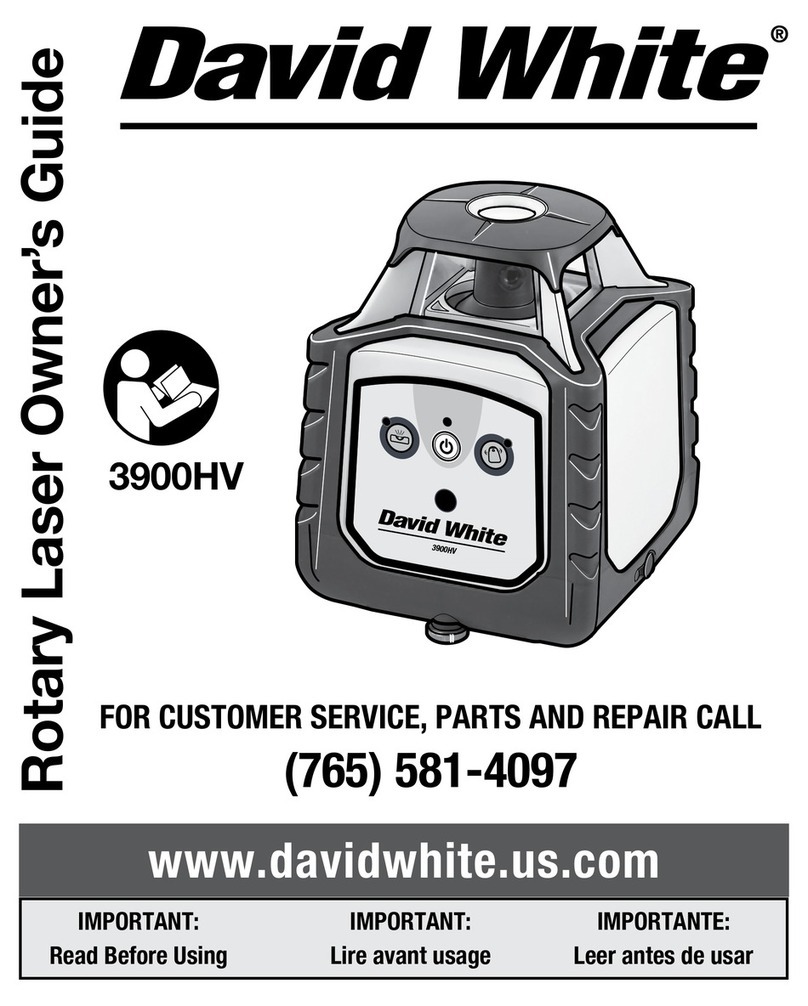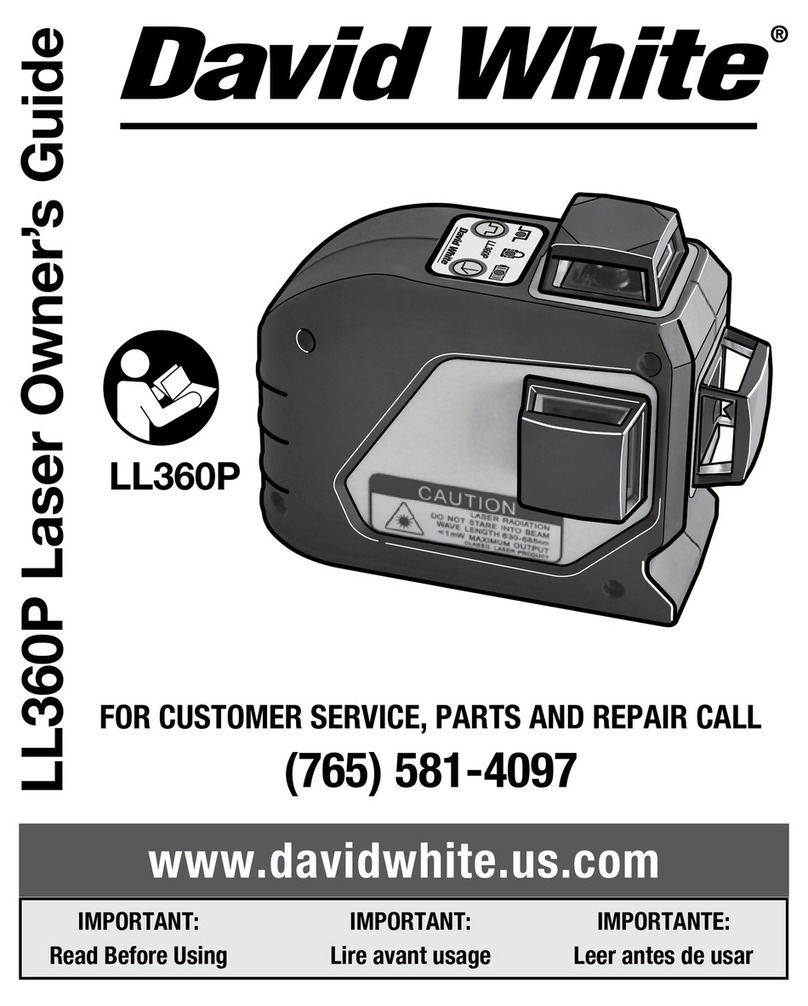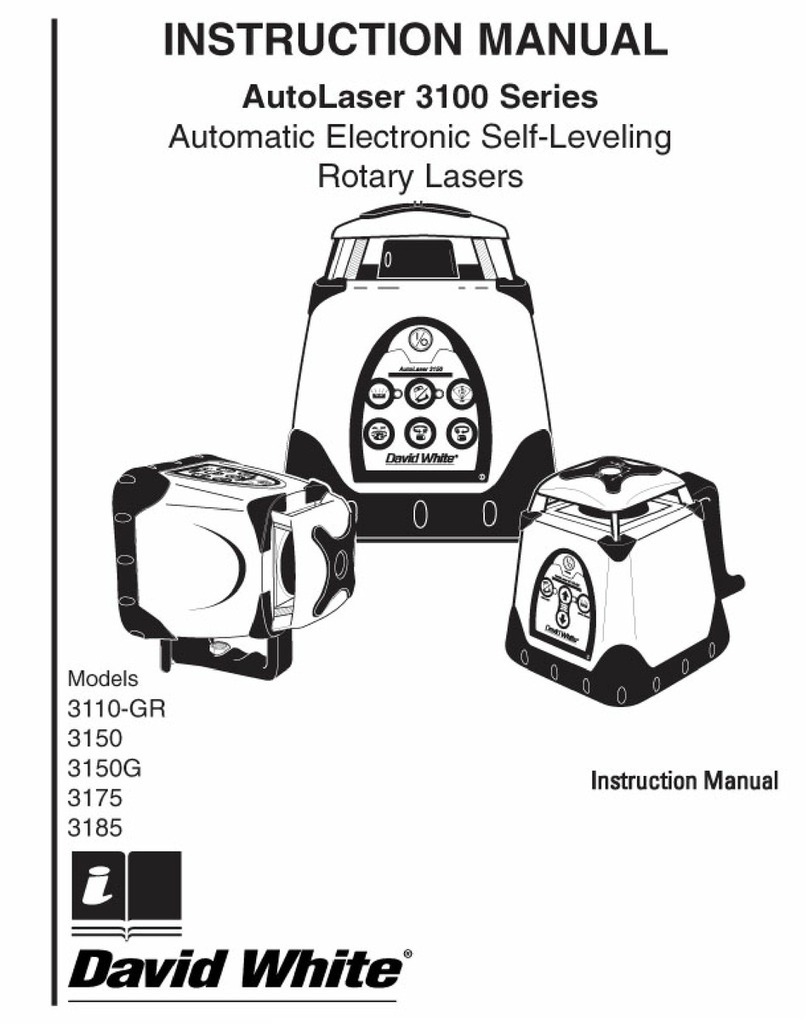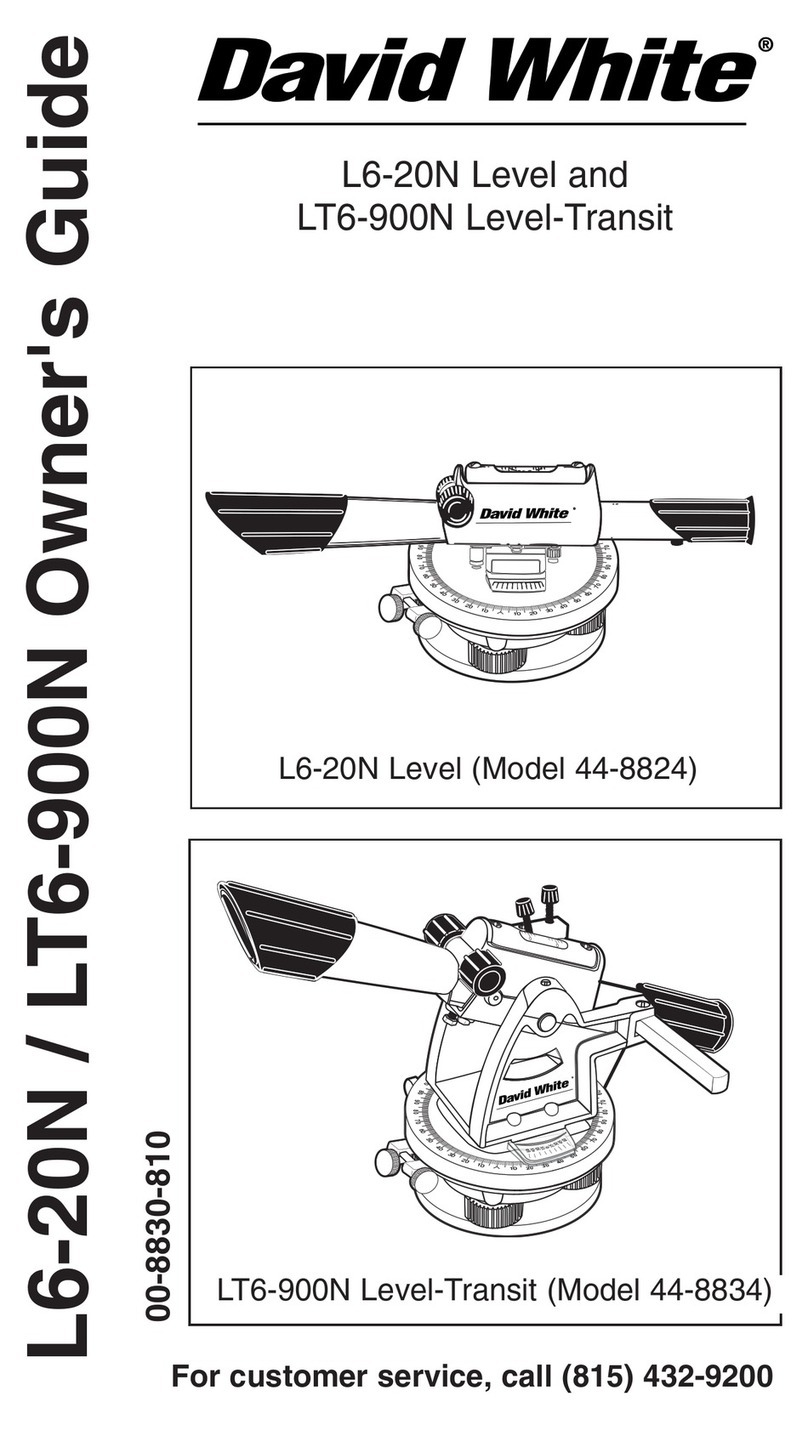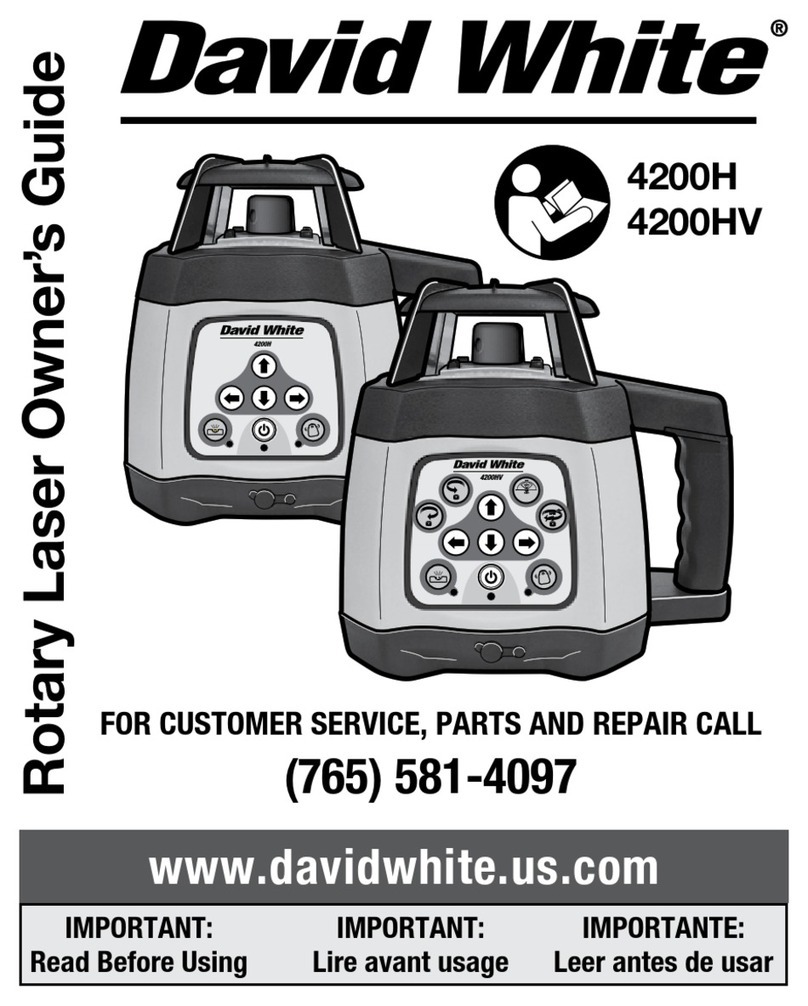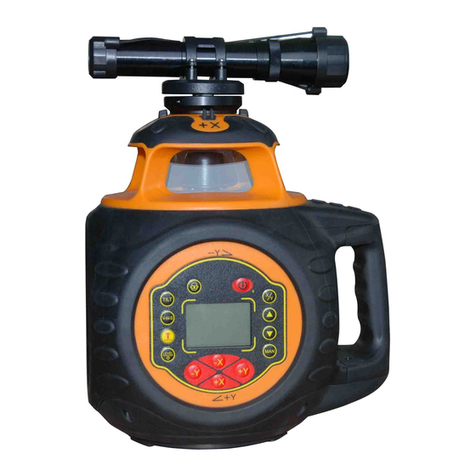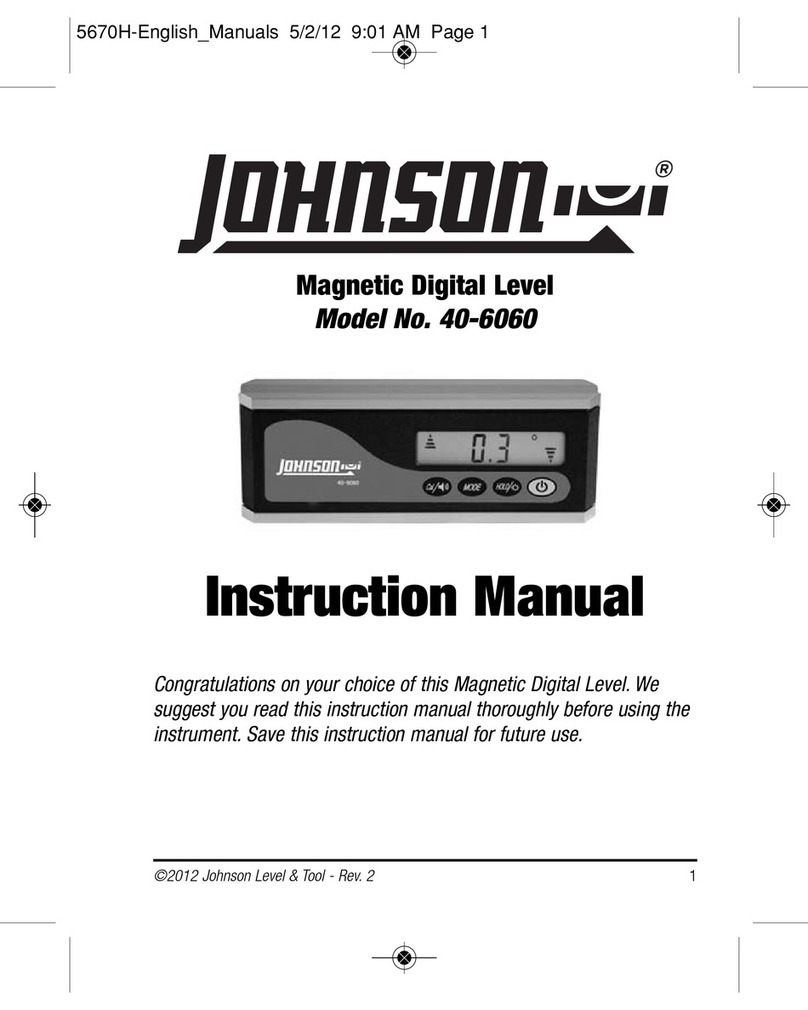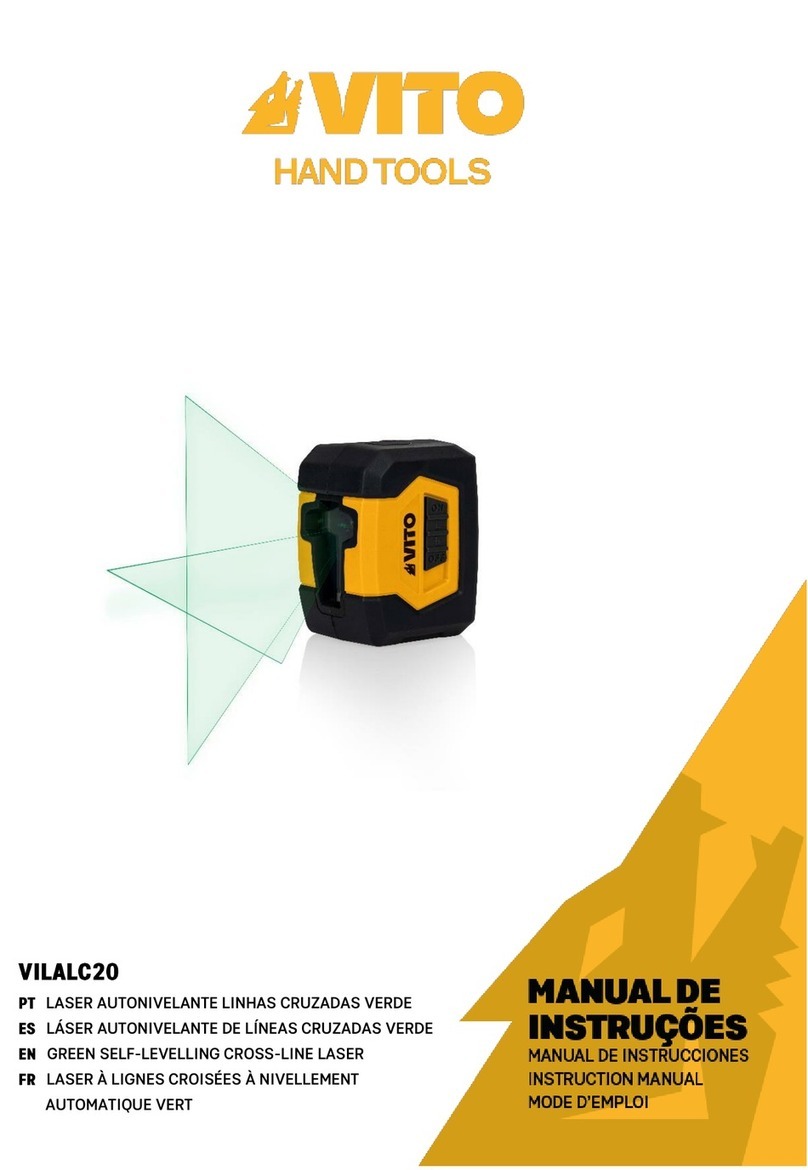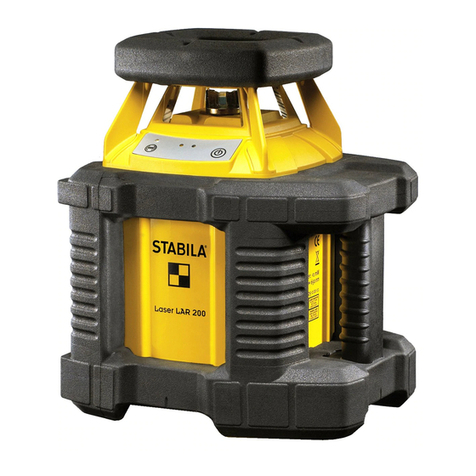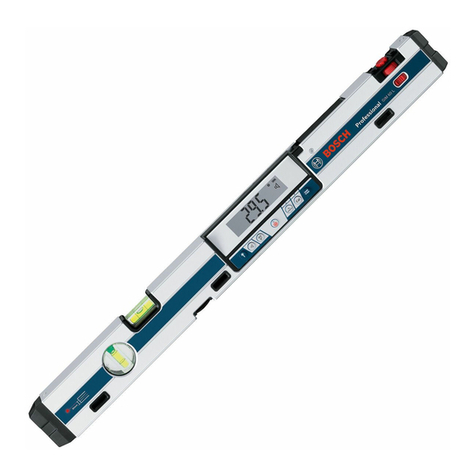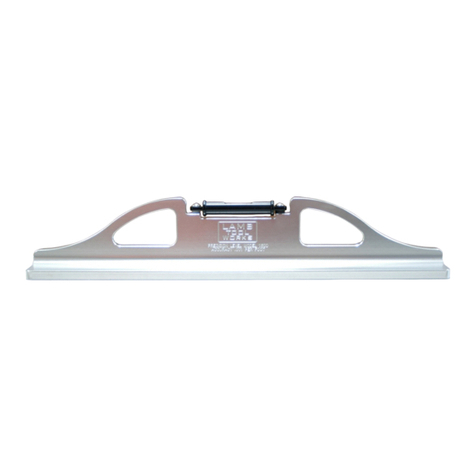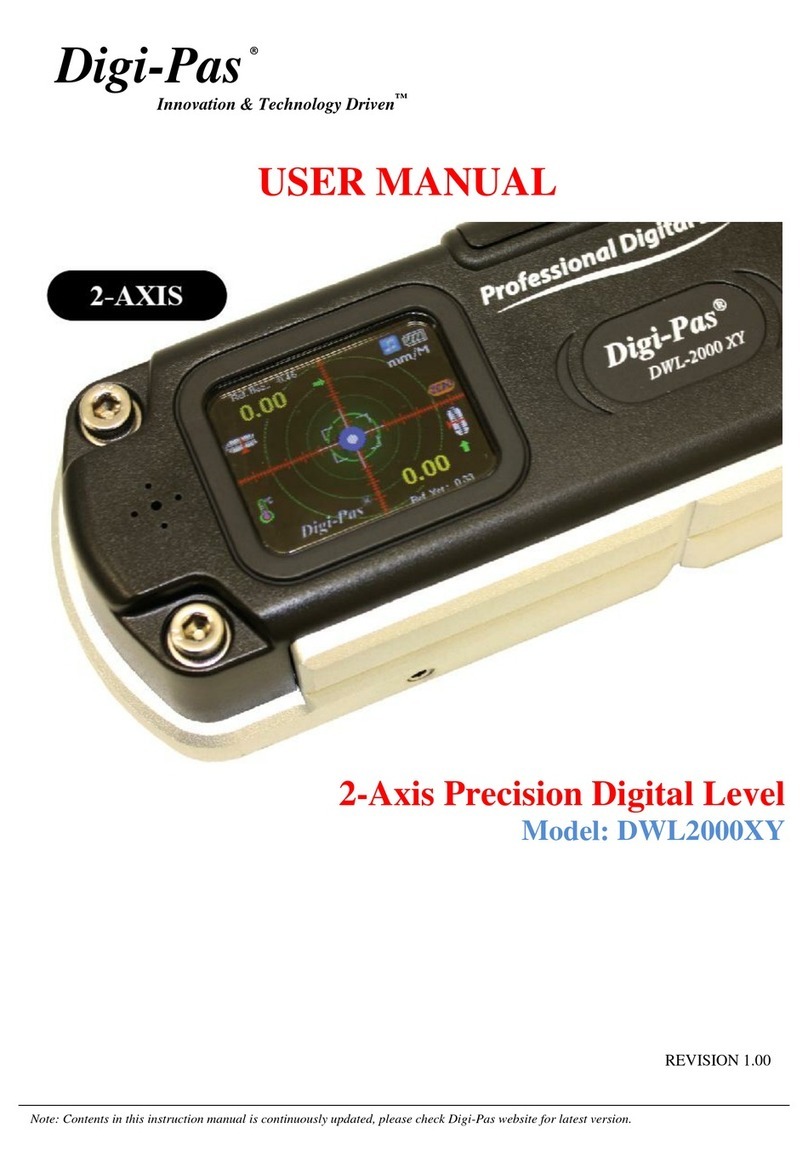David White LT8-300LTU User manual

FOR CUSTOMER SERVICE, PARTS
AND REPAIR CALL
(765) 581-4097
LT8-300LTU
LT8-300LTULP
LT8-300LTU Owner’s Guide
www.davidwhite.us.com
IMPORTANT: IMPORTANT : IMPORTANTE:
Read Before Using Lire avant usage Leer antes de usar

-2-
With David White
your sights are set on
precision and accuracy.
Congratulations! You’ve purchased a David White builder/contractor instrument,
known throughout the world for precision and accuracy.
The purpose of this user’s guide is to acquaint you with the instrument, its
components, safety, proper care and handling.
Our levels, level-transits and transits are constructed to withstand extremely
rugged field use. Like all precision instruments, however, they should be treated
with reasonable care to prolong life and accuracy.
All instruments are adjusted when they are shipped from the factory. It is the
customer’s responsibility to check and to ensure instruments are adjusted prior
to using.
David White is not responsible for errors caused by instruments that are out of
adjustment.
Contact your distributor, dealer or David White for information on the nearest
facility to check if your instrument is properly adjusted.
All specifications are subject to change without notice.

-3-
1
15
3
6
10
12
7
9
13
25
11
4
14
16
17
8

-4-
GENERAL SAFETY RULES
!WARNING Read all instructions. Failure to follow all instructions listed below
may result in serious injury.
!WARNING When moving a tripod-mounted instrument, handle with care. Carry
only in an upright position. Do not carry over your shoulder or in a
horizontal position. Improper handling may result in instrument damage
Handle the instrument by its base when removing from the case or attaching to a tripod.
Never use force on any parts of the instrument. All moving parts will turn freely and easily
by hand.
Check the leveling and indication accuracy of the measuring tool each time before using
and after longer transport of the measuring tool.
Protect the measuring tool against moisture and direct sun light.
Do not subject the instrument to extreme temperatures or variations in temperature.
As an example, do not leave it in vehicles for long time. In case of large variations in
temperature, allow the measuring tool to adjust to the ambient temperature before
putting it into operation. In case of extreme temperatures or variations in temperature,
the accuracy of the measuring tool can be impaired.
Avoid any impact to or dropping of the measuring tool. After severe exterior effects to
the measuring tool, it is recommended to carry out an accuracy check (see “Check”,
page 8) each time before continuing to work.
Place the instrument in the provided case when transporting it over larger distances
(e.g. in the car). Ensure that the instrument is correctly placed in the transport case.
When placing the instrument in the case.
When carrying instrument, always remove the instrument from the tripod when
transporting or carrying it at the jobsite. If the instrument must be carried on the tripod,
hold the instrument as vertically as possible and keep it in front of you. Never carry the
instrument horizontally over your shoulder.
When transporting instrument long distances, always place in the carrying case.
SAVE THESE INSTRUCTIONS
INTENDED USE
The instrument is intended for determining and checking precise horizontal partitions.
360° telescope rotation allows you to see directly below the instrument for pipe laying
applications.

-5-
FEATURES
The numbering of the product features
shown refers to the illustration of the
measuring tool on the graphic page.
1. Telescope objective lens
2. Sighting notches
3. Eyepiece
4. Focusing Knob
5. Instrument level vials (2)
6. Horizontal circle
7. Horizontal circle lock
8. Horizontal vernier
9. Horizontal clamp
10. Horizontal tangent
11. Vertical clamp
12. Vertical tangent circle
13. Shifting center
14. Four leveling screws
15. 5/8-11 thread base
16. Laser plummet
17. Plate level vial
TECHNICAL DATA
LT8-300LTU
RANGE: Up to 400 ft (120 m)
ACCURACY:
within 3⁄16 in at 150 ft
(5 mm at 45 m)
TELESCOPE
Length 8-1/2 in (216 mm)
Minimum focus 6 ft (1.8 m)
Aperture 1.257 in (32 mm)
Power 26X
Field of view 1' 9" @ 100 ft
(54 cm @ 30 m)
No. of lenses 8
Stadia Ratio 1:100
HORIZONTAL CIRCLE
Graduation
diameter
4-5/8 in (117 mm)
Graduations Each 1°
Numbers Each 10°, 0-90-0°
LT8-300LTU
Vernier Double direct to 5
min.
CENTER
Type Wide-stance dual
row ball bearings
LEVEL VIAL-TELESCOPE
Accuracy 120 sec.
per 2 mm
PLATE VIAL
Accuracy 360 sec.
per 2.5mm
TRIPOD
Type Use a heavy-duty
5/8-11 tripod

-6-
GENERAL DESCRIPTION
Telescope
The telescope 1provides a sharp image
magnified 26 times. This means the
object sighted appears 26 times closer
than it would with the naked eye.
Sighting and Focusing
The vial notches 2are used for preliminary
sighting. To focus on an object, sight
through the eyepiece 3and bring the
crosshairs into focus by turning the
eyepiece cap 3. After the crosshairs
are sharp and distinct, look through
the eyepiece at the object and turn the
focusing knob 4until the object appears
sharp and clear.
All focusing is internal. The telescope
does not move outward or inward
as objects are focused. David White
Universal instruments utilize the smooth
precision of a rack and pinion mechanism
for focusing.
Focus range is from six feet to infinity. For
closer focus, turn the knob clockwise. For
farther focusing, turn counterclockwise.
Leveling Vial
The instrument leveling vial 5is factory
aligned and is graduated to facilitate
centering the bubble.
Horizontal Measuring
The horizontal circle 6can be rotated for
easy angle setting and reading and is
divided in quadrants (0-90°). The circle is
marked by degrees and numbered every
10 degrees.
The horizontal circle lock 7assures
accuracy by preventing the horizontal
circle form being moved accidentally.
Turn clockwise to tighten.
The horizontal vernier 8permits dividing
whole degrees into fractions of 1⁄12° (5
minutes).
Approximate horizontal sightings are held
firmly in place by means of a clamp 9.
Then, precise horizontal settings can be
made with the tangent 10. The clamp
must be hand tightened firmly before the
tangent will function.
Shifting Center
The shifting center 13 facilitates accurate
placement of the instrument over a point.
Four screws 14 are used for leveling the
instrument. The instrument is mounted to
the tripod by screwing the 5/8-11 base to
the tripod head.
PREPARATION
This instrument is equipped with a laser
plummet and requires a CR2 lithium
battery.
Inserting/Replacing the Battery
Always turn off the laser plumment before
removing and replacing batteries.
To open the battery compartment 16,
unscrew the cap. Insert the battery.
Insert battery using correct polarity
as illustrated.
When the battery becomes weak, the
brightness of laser plummet beam will
weaken.
Remove the battery from the tool when
not using it for extended periods. When
storing for extended periods, the batteries
can corrode and discharge themselves.

-7-
OPERATION
Initial Operation
!WARNING Protect the instrument
against moisture and
direct sun light.
Do not subject the instrument to extreme
temperatures or variations in temperature.
As an example, do not leave it in vehicles
for long time. In case of large variations
in temperature, allow the measuring tool
to adjust to the ambient temperature
before putting it into operation. In case
of extreme temperatures or variations
in temperature, the accuracy of the
measuring tool can be impaired.
Avoid heavy impact or falling of the
instrument. After heavy exterior impact on
the instrument, an accuracy check should
always be carried out before continuing
to work.
Setting Up Instrument
!WARNING It is important that the
tripod is set up firmly.
Make sure that the tripod points are well
into the ground. On paved surfaces, be
sure the points hold securely.
The legs should have about a 3-1⁄2 foot
spread, positioned so the top of the tripod
head appears level.
If using a tripod with adjustable legs, be
sure the leg clamps are securely hand
tightened.
Before setting up your instrument, be sure
clamps are loosened.
Attach the instrument to the tripod
securely, hand tightening the instrument
base to the 5/8-11 tripod head.
Setting Up Over a Point
!WARNING Never use force on any
parts of the instrument.
All moving parts will turn freely and easily
by hand.
The LT8-300LTULP is equipped with a
laser plummet.
This eliminates the need to use a plumb
bob. The instrument is set up over
a reference point by using the laser
plummet beam (LT8-300LTULP).
Move the tripod and instrument over the
approximate point. (Be sure the tripod
is set up firmly again. Loosen leveling
screws and shift the instrument laterally
until the instrument is positioned directly
over the point.
To switch ON the laser plummet, press
and release the ON switch 16. A laser
point will project through the center of the
instrument to the reference point (a stake
on the ground).
- Line up the tripod over the reference
point.
- Remove the plumb bob hanger from
the center stud of the tripod.
- Attach the instrument to the tripod.
- Level the instrument.
- Line up the laser point with the
reference point.
If necessary, the instrument can be
shifted by loosening the tripod center stud
and sliding the instru ment from side to
side for proper positioning.
Leveling the Instrument
Set the instrument leveling screws.
Turn down the leveling screws until firm
contact is made with the instrument base.
!CAUTION Do not overtighten the
leveling screws. It is
very possible to overtighten the leveling
screws. Only a firm contact between the
screws and the base is necessary. If the
instrument shifts on the base, turn down
the screw more firmly by hand.
Leveling the instrument so the vial bubble
remains centered through a 360° rotation
of the telescope is the most important
operation in preparing to use your
instrument.

-8-
When leveling your instrument, be sure
not to touch the tripod. Follow these
instructions carefully.
Line up the telescope so that it is directly
over one pair of leveling screws.
Grasp these two leveling screws with the
thumb and forefinger of each hand.
Turn both screws at the same time by
moving your thumbs toward each other
or away from each other, until the bubble
is centered.
When the bubble is centered, rotate the
telescope 90 degrees over the second
pair of leveling screws and repeat the
thumbs in, thumbs out leveling procedure
until the bubble is again centered.
Shift back to the original position and
check the level.
Make minor adjustments with leveling
screws if necessary.
Final Level Check
Rotate the telescope over each of four
leveling points to be sure the bubble
remains centered.
Rule for Quick and Simple
Leveling
THUMBS IN, THUMBS OUT. Turn
BOTH screws equally and simultaneously.
Practice will help you get the feel of the
screws and the movement of the bubble.
It will also help to remember that the
direction your left thumb moves is the
direction the bubble will move.
Reading the Circle and Vernier
The 360° horizontal circle 6is divided in
quadrants (0 - 90°). The circle is marked
in degrees and numbered every 10
degrees. The horizontal circle is referred
to as the circle or degree scale.
For very precise readings, Universal
instruments are equipped with a vernier 8
which divides each degree on the circle or
arc into 12 equal parts of 5 minutes each.
There are 60 minutes (60’) in a degree.
The vernier scale 8is read in the same
direction (right or left) as you’re reading
the degree scale.

-9-
The following examples will explain how
to read the degree and vernier scales on
the circle.
Exact Degree Reading
The point at which 0 on the vernier scale
touches the circle. If the 0 coincides
exactly with a degree line on the circle,
your reading will be in exact degrees.
There are no fractions of degrees, or
minutes, to be added to the reading. The
horizontal circle reading in 40°.
Fraction (Minutes) Reading
If the 0 on the vernier does not coincide
exactly with a degree line, your degree
reading is the line which the 0 has just
passed, reading up the degree scale, plus
a fraction of the next degree.
To determine the fraction, or minutes:
- Start at 0 on the vernier and read up
the vernier scale (in the same direction
as you’re reading the degree scale) until
you find a minute line that coincides
exactly with a degree line.
- 41° was the last degree line passed on
the circle.
Reading to the right on the vernier
scale, the minute line which coincides
exactly with a degree line is 25’
(Reading is 41° 25’).
Remember, each line on the vernier scale
represents 5’, so you will be reading 5’,
10’, etc. the circle degree scale is being
read to the left.
When reading the circle degree scale to
the left, read up the vernier scale in the
same direction.
- Reading to the left on the vernier scale
8, the minute line which coincides
exactly with a degree line is 45’.
Sighting and Focusing the
Telescope
The telescope 1provides a sharp image
magnified 26 times. This means the
object sighted appears 26 times closer
than it would with the naked eye.
Avoid touching the tripod while sighting.
- Aim the telescope at the object and
sight first through the notches 2on
the top of the level vial for preliminary
sighting. Look through the telescope
eyepiece 3and focus the crosshairs
using the eyepiece adjuster 3.
- Then bring the object into focus using
the focusing knob 4.
- Rotate the instrument until the
crosshairs are positioned on or near
the target. Tighten the horizontal clamp
9and make final settings with the
tangent fine tuning knob 10 to bring the
crosshairs exactly on point.
When sighting through the telescope,
keep both eyes open. You will find that
this eliminates squinting, will not tire your
eyes and gives the best view through the
telescope.
Remember to avoid touching the tripod
while sighting.

-10-
Stadia Reticle.
All LT8-300 series instruments have a
glass stadia reticle with two additional
horizontal lines for use in determining
distance.
Stadia
Hairs
AB
L
Read the length “ ” of a level rod shown
between the stadia hairs.
Stadia
Hairs
AB
L
The distance to the target is “ ”
multiplied by 100. The distance between
point A and point B is L.
L = 100 x “ ”
Stadia
Hairs
AB
L
Pipe Laying Application
1.
2.
3.4.
1. Set up the LT8-300LTU over your
pipe laser.
2. Sight on the far point and lock the
horizontal screw.
3.
Transit over the pipe laser and align the
front and back of the pipe laser with
the cross hair in the line transfer unit.
4. Transit out to point in ditch. Adjust
laser beam left or right to center it in
the crosshairs.
Store and transport the tool only in the
supplied protective case.
Keep the tool clean at all times.
Do not immerse the tool into water or
other fluids.
Wipe off debris using a moist and soft cloth.
Do not use any cleaning agents or solvents.
Regularly clean the surfaces at the exit
opening of the laser in particular, and pay
attention to any fluff of fibers.
If the tool should fail despite the care taken
in manufacturing and testing procedures,
repair should be carried out by an authorized
after-sales service center for Dave White’s
SitePro instruments.
In all correspondence and spare parts
orders, please always include the
model number and serial number of the
instruments.
All precision instruments should be cleaned,
lubricated, checked and adjusted ONLY at a
qualified instrument repair station or by the
manufacturer, at least once a year.
In case of repairs, send in the instrument
packed in its protective case.
ENVIRONMENT PROTECTION
Recycle raw materials
& batteries instead of
disposing of waste. The
unit, accessories, packaging
& used batteries should be sorted for
environmentally friendly recycling in
accordance with the latest regulations.
MAINTENANCE AND SERVICE

-11-
LIMITED WARRANTY
Dave White’s SitePro (“Seller”) warrants to the original purchaser only, that all David
White laser tools and optical instruments will be free from defects in material or
workmanship for a period of two (2) years from date of purchase.
SELLER’S SOLE OBLIGATION AND YOUR EXCLUSIVE REMEDY under this Limited
Warranty and, to the extent permitted by law, any warranty or condition implied by
law, shall be the repair or replacement of parts, without charge, which are defective
in material or workmanship and which have not been misused, carelessly handled,
or misrepaired by persons other than Seller or Authorized Service Center. To make
a claim under this Limited Warranty, you must return the complete laser, optical
instrument or David Whte product, transportation prepaid, to SITEPRO Service
Department or Authorized Service Center. Please include a dated proof of purchase
with your tool. For locations of nearby service centers, please call 1-855-354-9881.
THIS LIMITED WARRANTY DOES NOT APPLY TO ACCESSORY ITEMS SUCH
AS TRIPODS, RODS, HAND LEVELS, FIELD SUPPLIES, TAPES, MOUNTING
DEVICES AND OTHER RELATED ITEMS. THESE ITEMS RECEIVE A 90 DAY LIMITED
WARRANTY.
To make a claim under this Limited Warranty, you must return the complete product,
transportation prepaid. For details to make a claim under this Limited Warranty please
visit www.davidwhite.com or call 1-855-354-9881.
ANY IMPLIED WARRANTIES SHALL BE LIMITED IN DURATION TO ONE YEAR
FROM DATE OF PURCHASE. SOME STATES IN THE U.S., AND SOME CANADIAN
PROVINCES DO NOT ALLOW LIMITATIONS ON HOW LONG AN IMPLIED
WARRANTY LASTS, SO THE ABOVE LIMITATION MAY NOT APPLY TO YOU.
IN NO EVENT SHALL SELLER BE LIABLE FOR ANY INCIDENTAL OR
CONSEQUENTIAL DAMAGES (INCLUDING BUT NOT LIMITED TO LIABILITY FOR
LOSS OF PROFITS) ARISING FROM THE SALE OR USE OF THIS PRODUCT. SOME
STATES IN THE U.S., AND SOME CANADIAN PROVINCES DO NOT ALLOW THE
EXCLUSION OR LIMITATION OF INCIDENTAL OR CONSEQUENTIAL DAMAGES, SO
THE ABOVE LIMITATION MAY NOT APPLY TO YOU.
THIS LIMITED WARRANTY GIVES YOU SPECIFIC LEGAL RIGHTS, AND YOU MAY
ALSO HAVE OTHER RIGHTS WHICH VARY FROM STATE TO STATE IN THE U.S.,
OR PROVINCE TO PROVINCE IN CANADA AND FROM COUNTRY TO COUNTRY.
THIS LIMITED WARRANTY APPLIES ONLY TO PRODUCTS SOLD WITHIN THE
UNITED STATES OF AMERICA, CANADA AND THE COMMONWEALTH OF PUERTO
RICO. FOR WARRANTY COVERAGE WITHIN OTHER COUNTRIES, CONTACT
YOUR LOCAL SITEPRO DEALER OR IMPORTER.
David White is a registered trademark and distributed exclusively by SitePro.

42346D8879 09/15 Printed in China
© Dave White’s SitePro 7619 S 1150 E Otterbein, IN 47970
Tel. +1 (765) 581 4097
This manual suits for next models
1
Table of contents
Other David White Laser Level manuals
Popular Laser Level manuals by other brands
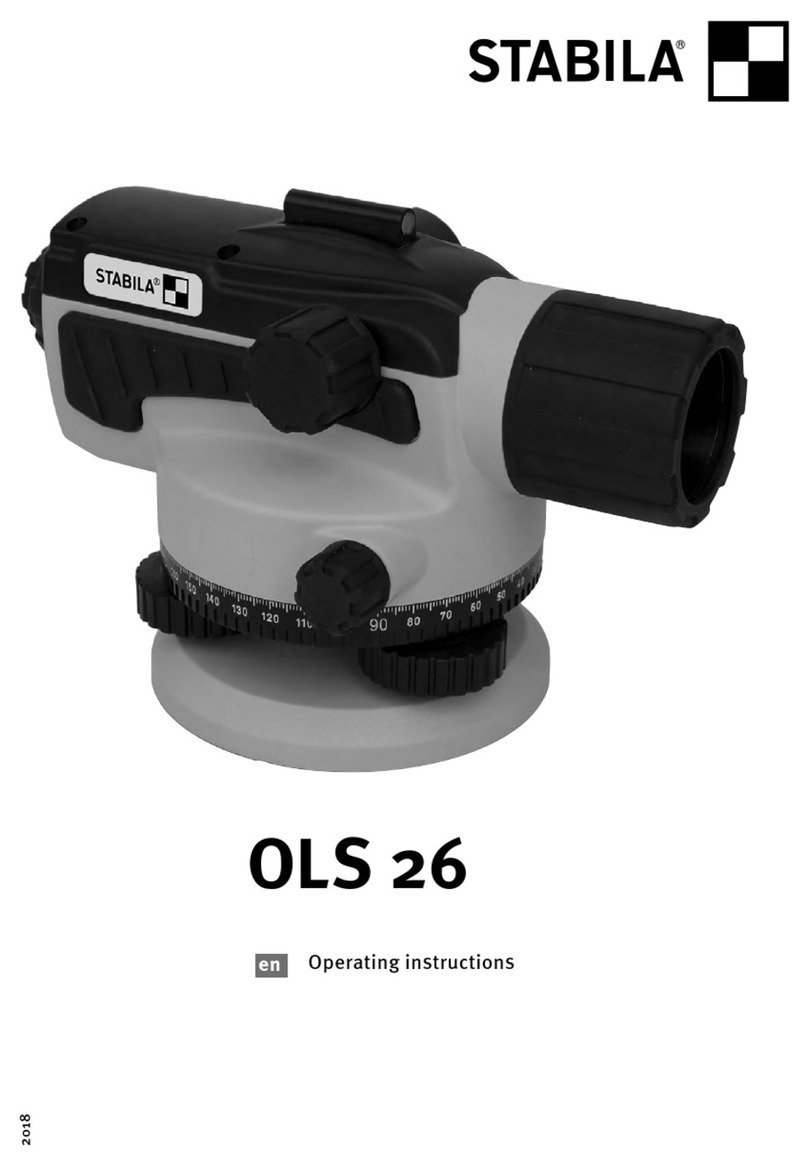
Stabila
Stabila OLS 26 operating instructions
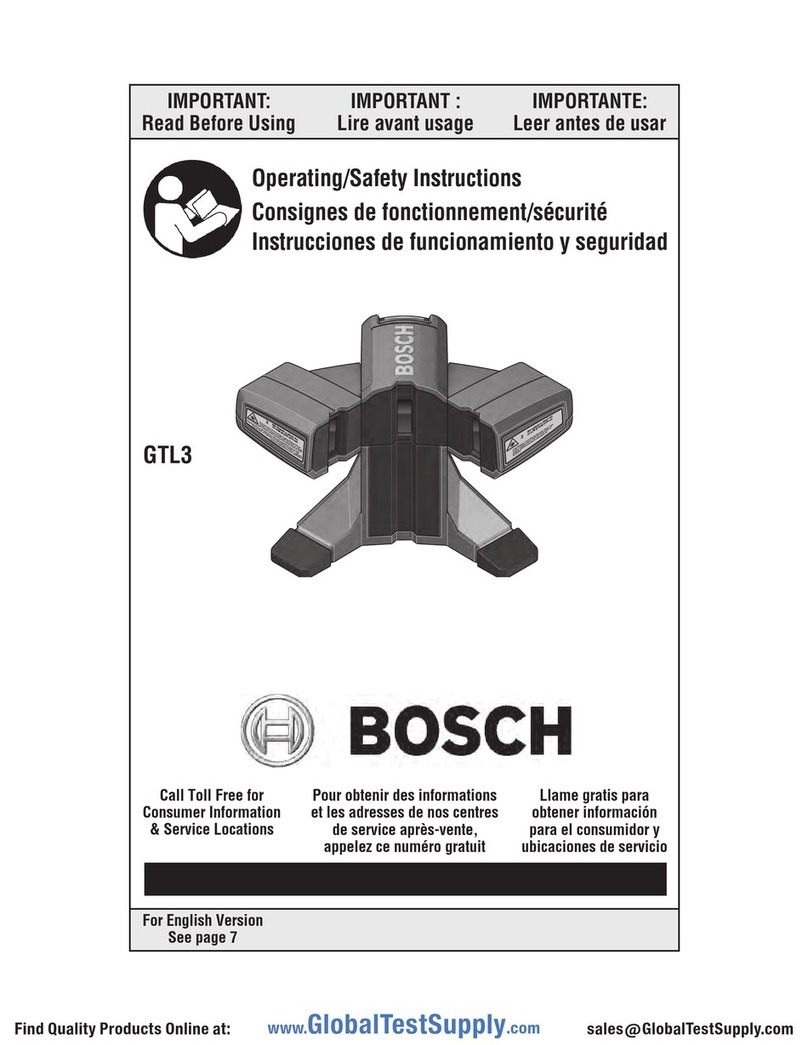
Bosch
Bosch GTL 3 Professional instructions
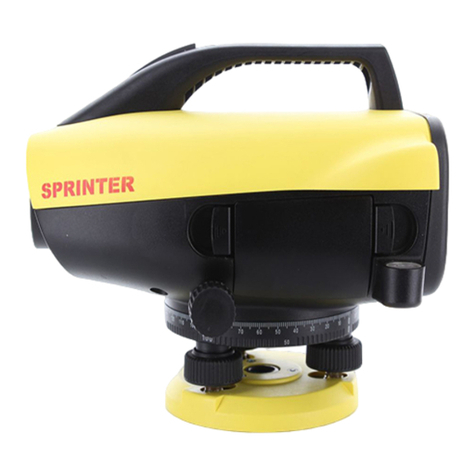
Leica Geosystems
Leica Geosystems SPRINTER 100 user manual

Pittsburgh
Pittsburgh Pittsburgh Corner Laser Level Instructions and precautions
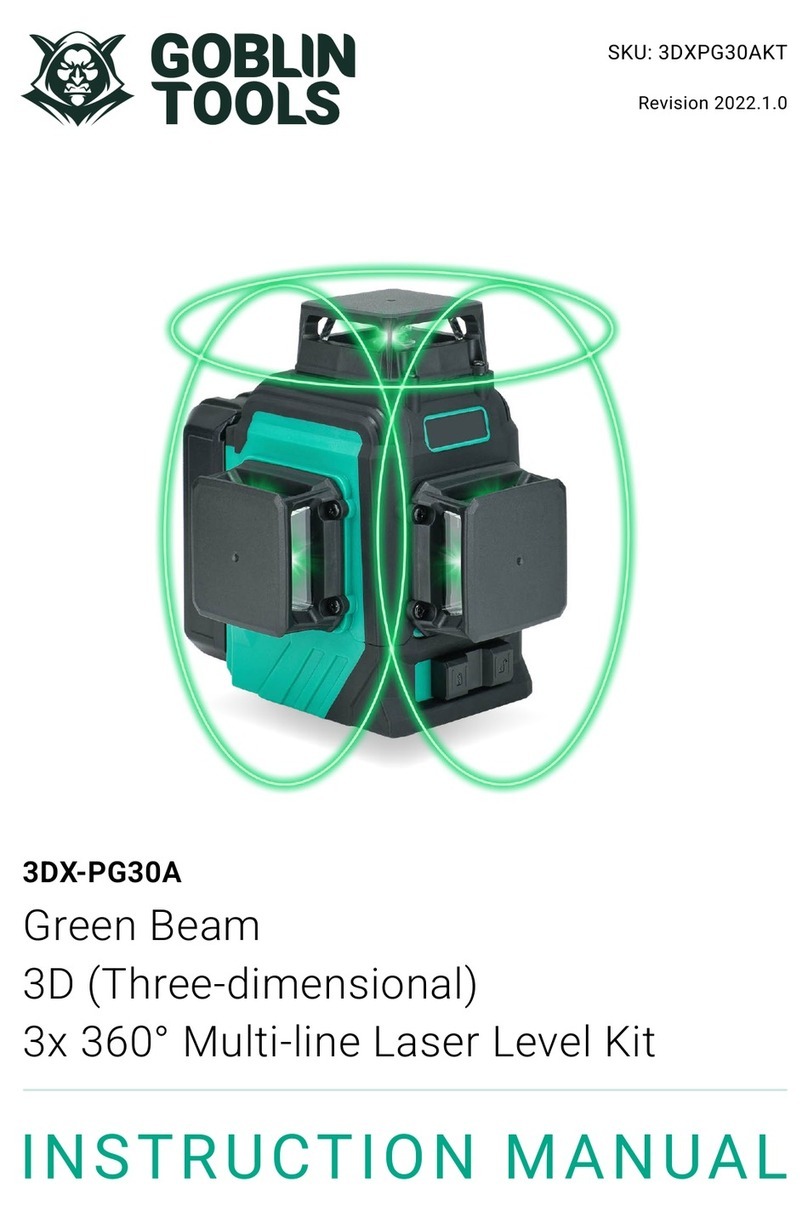
Goblin
Goblin 3DX-PG30A instruction manual
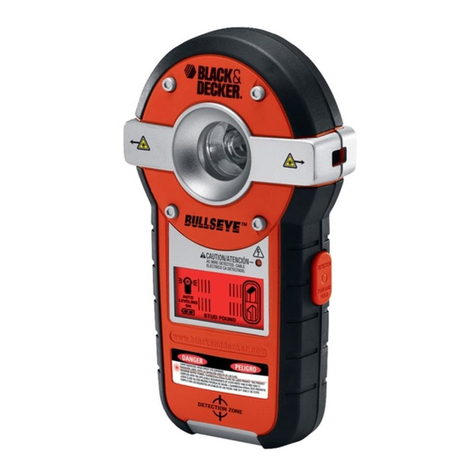
Black & Decker
Black & Decker BullsEye BDL190S instruction manual
